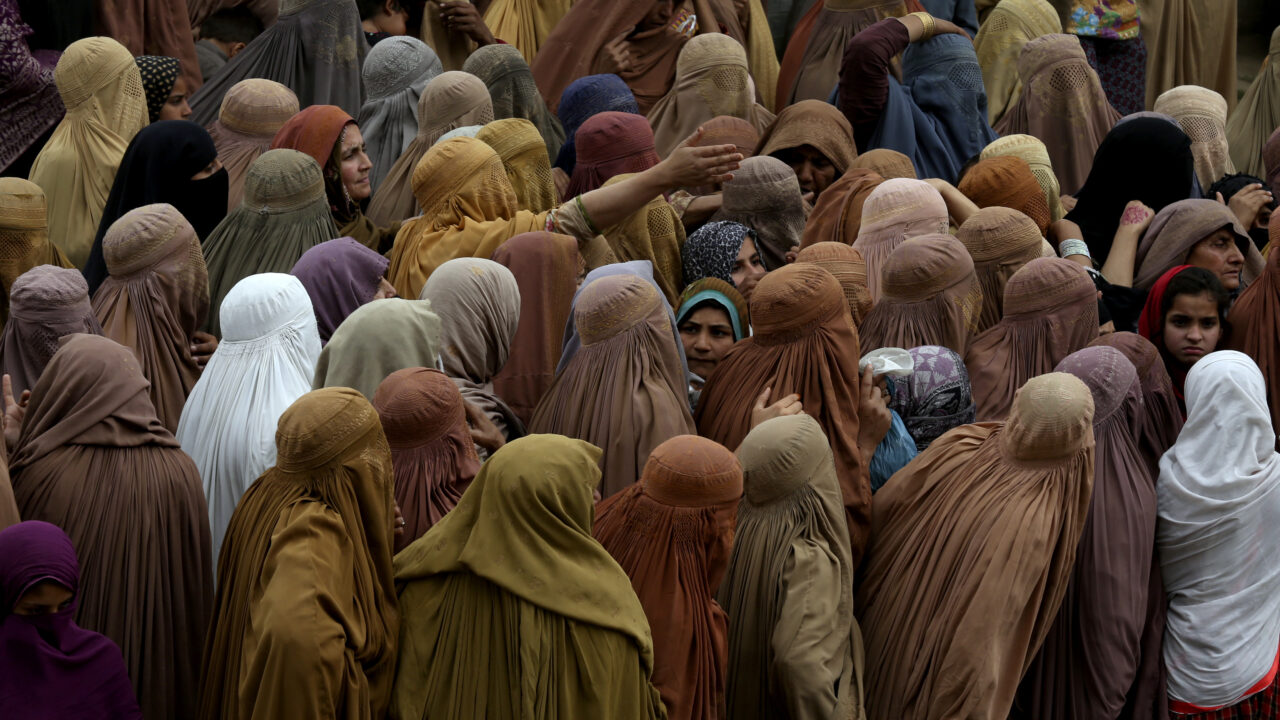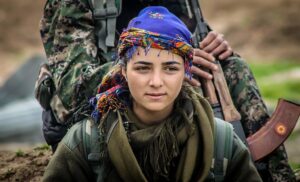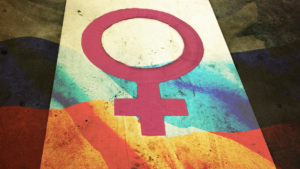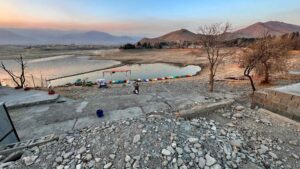In Pakistan, the Quest for Gender Equality Marches On
It's been 75 years since independence, and progress is still missing. Women gather and wait their turn to get a free sack of wheat flour at a distribution point, in Peshawar, Pakistan, March 29, 2023. AP Photo / Muhammad Sajjad
Women gather and wait their turn to get a free sack of wheat flour at a distribution point, in Peshawar, Pakistan, March 29, 2023. AP Photo / Muhammad Sajjad
KARACHI, PAKISTAN — On April 13, a Pakistani woman won a spot on Time’s list of 100 most influential people in the world in 2023. Sherry Rahman, who is Pakistan’s environment minister, earned this distinction for her concerted and effective climate advocacy. Rahman was a journalist before she entered politics and made a name for herself for her work in parliament supporting women’s causes. This was an occasion to celebrate and Rahman was widely lauded.
Many who follow events in Pakistan might wonder why, just a month prior, a country that has women like Rahman should raise such a ruckus about the oppression of women on International Women’s Day. On that occasion, slogans were chanted against the entrenched forces of patriarchy. To understand this dichotomy, one must understand the women’s movement in Pakistan.
Aurat March
On March 12, some 4,000 women assembled at Burns Gardens in downtown Karachi for the Sixth Aurat (Urdu for “woman”) March that has come to signify the most visible show of strength and solidarity by Pakistan’s female population. It was an event full of paradoxes — as the women’s situation in Pakistan has always been.
The event’s date change was met with some resistance. “The march lost its symbolic value. We associate March 8 with Women’s Day. You can’t just change it to suit your own convenience,” one regular marcher told me. But the organizers defended their move by saying, “We did it so that the working-class communities we work with do not have to experience the distress of losing out on their daily wages.”
It was, however, conceded by all that the attendance at the march was much lower than in previous years, when it had reached a peak of 10,000. Perhaps the date change was not a wise move? Sunday is a weekly holiday. Many women could not attend the march as they had to stay home to attend to the needs of their husbands, who were not at work as they normally would be on a weekday. This realization was an unhappy reminder of how far we are from realizing gender equality.
This year, the Karachi march was peaceful and well-organized. But in Lahore and Islamabad, marchers clashed with police. By virtue of its better planning, the Karachi march was more meaningful in terms of conveying its message. There were more performances, including skits, songs and dances. Speeches were shorter and there were fewer of them. (They can become tiresome. Slogans that allow everyone to participate are more articulate than long, drawn-out orations.)
By adding a lot of drama, the organizers attracted a lot of attention. One white banner — several meters long with a slogan printed in red — served to remind all: “Tumhara zulm yaad rakha jaaey ga” (“Your cruelty will always be remembered”). As if to seal this promise, the participants dipped their hands in a pail of red paint and made an imprint of their palms on the banner. Other symbolic gestures came as powerful performances commemorated the bravery of the victims of male treachery: Noor Muqaddam, who was beheaded by her boyfriend; transgender Shahzadi Rai, whose home was attacked several times by a mob; the Hindu students of Karachi University, who were attacked by their colleagues from the Jamiat-e-Islami (a religious party) for observing Holi, a Hindu religious festival. At the Burns Gardens march, many Muslim women joined their Hindu co-marchers in the ritual of splashing colored water on one another, as is traditionally done on Holi.
One white banner — several meters long with a slogan printed in red — served to remind all: “Tumhara zulm yaad rakha jaaey ga” (“Your cruelty will always be remembered”)
“We marched against hunger, we marched for social security, we marched for a living wage, we marched for an end to bonded labor, we marched for the rehabilitation of flood victims, we marched for an end to mob violence, we marched for an end to domestic violence, we marched for the Transgender Persons Protection Act 2018 (which is under threat from religious extremists), we marched to end forced conversions and we marched to end enforced disappearances,” Sheema Kermani, a performance artist and women’s rights activist who founded the march in 2018, wrote to me in an email. Kermani is also the founder of Tehrik-e-Niswan, a “cultural action group” that uses performing arts to foster awareness on rights issues.
Certainly, this was a long list of causes to justify the march. In fact, one could add another dozen or so — for Pakistan is, after all, a “hard country” (to borrow a phrase from the title of a book by British author and Taliban expert Anatol Lieven).
Yet, it is not just the gravity of the issues that need to be addressed but also the fact that these issues impact men as well. This is what I would call a progressive and inclusive approach.
Nevertheless, the slogans raised with such passion compensated for the missing feminist dimension. “Trafficking of women will not do. Kick down the wall of patriarchy. My religion is my choice (raised in the context of the forced conversion of women),” were slogans that filled the air in Burns Gardens that afternoon. They were enough to conscientize women, many of whom are not even fully aware of their own rights.
Status of Women in Pakistan
In August 2022, Pakistan celebrated the 75th anniversary of its independence. This is a period long enough for it to show progress in every walk of life. Unfortunately, this progress is largely missing. Now, data is available to confirm the government’s failure to uplift the status of the female population.
Take female education, as an example. It is universally recognized that education is the foundation on which progress is built. It equips a woman to think and seize the opportunities that come her way. She opts for fewer children, educates them and has the knowledge to look after her family’s health. She is confident and enjoys self-esteem. She takes up a job to empower herself economically.
What has the country offered her? The female literacy rate in Pakistan stands at 51.9%. Primary school enrollment for girls is 45%, and it is generally believed that there was a massive dropout of students during the COVID-19 pandemic that has not been recorded. The economic crisis and phenomenal inflation have also hurt the education of girls from the impoverished classes.
This lack of education has given patriarchy an upper hand. A large majority of women have no control over their reproductive health. They cannot even assert themselves in matters such as family size. Pakistan’s population growth stands at 1.8% with the total fertility rate at 3.2 (meaning that the average number of children a woman aged 15-49 is expected to have in her lifetime is three).
The female literacy rate in Pakistan stands at 51.9%. Primary school enrollment for girls is 45%, and it is generally believed that there was a massive dropout of students during the COVID-19 pandemic that has not been recorded.
In such conditions, it is hardly surprising that most women do not have paid jobs. They constitute only 23% of the total workforce. In rural areas, women share their husband’s work without receiving any wages for their labor. In the urban centers, if a woman does not hold a job, she is often a homemaker whose work as a babysitter, cook, washerwoman, cleaner and personal attendant to her husband leaves her financially dependent on her husband, who often has no understanding that a woman also has rights. Small wonder Pakistan ranks 145th out of 156 on the gender gap index.
This is, however, not the whole truth. A section of women who managed to develop faster than their less privileged compatriots have done much better. The fact is that Pakistan has a class-based society few acknowledge. It amounts to two unequal parts being squeezed into one state. Since power and privileges are skewed, an elitist top dominates the pyramid.
The absence of egalitarianism has resulted in the paradoxes I pointed out earlier. After all, in Benazir Bhutto, Pakistan had a female prime minister who studied at Oxford, while the majority of its female citizens have not gone to school at all. What must be conceded is that, in this scenario, patriarchy has the upper hand even in the class that controls the country.
That is why Imran Khan, who served as prime minister from 2018 to 2022, could say in an interview with Jonathan Swan, “If you raise temptation in the society … it will have consequences” and get away with it. He also added, “If a woman wears very few clothes it will have an impact on a man unless they are robots.”
A change of mindset is needed. That is precisely what the Aurat March — led by educated and enlightened women — set out to do.
How does one view the women’s movement in Pakistan today?
If one were to look at a small, highly educated, privileged class of personally, politically and economically empowered women, one would be impressed. But one swallow does not a summer make. These are the 1% that Nobel Prize-winning economist Josef Stiglitz refers to in his writings (“The Price of Inequality”). This 1% has to be seen alongside the 99% to understand the whole.
The fact is that the plight of the huge majority tells a different story. Pakistan’s society is, on the whole, highly patriarchal. And when it comes to rights, women normally find themselves at a disadvantage. Culture, laws derived from the Islamic Shariah and incorporated into the legal system, and many customary practices are not kind to women.
That is why the women’s movement failed to develop in the early years of Pakistan. Women had been drawn out in the freedom struggle to strengthen the hands of the Muslim League (the party that demanded the creation of Pakistan as a Muslim state in 1947). But once the new country was born, the women were sent home and left to their own devices — or even pushed back to a secondary position.
Moreover, the politics of the nation’s early decades were dominated by factional power struggles that made the state’s quest for its own identity a challenge. There was no space for women’s rights to come to the forefront. There was no concept of women even having rights in those days. The wives of the ruling class created social welfare-oriented organizations to make the lives of the disadvantaged somewhat easier.
The female literacy rate in Pakistan stands at 51.9%. Primary school enrollment for girls is 45%, and it is generally believed that there was a massive dropout of students during the COVID-19 pandemic that has not been recorded.
Enlightenment was emerging in some segments of the female population, though not as an organized movement. Many of them started sending their daughters to school (more out of social compulsion). If the women who managed to acquire education sought entry into various professions, it was not a planned move. Rather, it was the resulting situation that generated pressure for them to join the various professions. It was the internationally driven feminist movement of the 1970s that gave rise to the enthusiasm of women in Pakistan to adopt careers and plan their own lives.
Seen against this backdrop, the emergence of various groups to fight for the rights of women and to conscientize them was a significant phenomenon.
It was Gen. Muhammad Zia ul-Haq’s military coup in 1977 and the imposition of harsh anti-women laws — under the guise of religion — that led to a reaction from women. Their education over the previous three decades had equipped them with the courage and awareness to resist the brutality of the military dictator who they felt violated their sense of justice.
Led by Kermani, who was among the first to feel the pinch of Gen. Zia’s orthodoxy, Tehrik-i-Niswan emerged in 1978. The group used the medium of dance, theatre and music to resist anti-women laws.
In 1981, the Women’s Action Forum was formed as a reaction to the harsh punishment handed down by a court (100 lashes and stoning to death) to a young married couple who tied the nuptial knot against the wishes of the girl’s father. Their crime? They had failed to follow fully the prescribed procedure in registering their marriage.
WAF achieved prominence in the 1980s because this was the period when Gen. Zia was trying hard to block the enlightenment that was emerging and threatened to transform the social environment. WAF was not hierarchically structured and functioned with great flexibility. It comprised eminent lawyers, activists, journalists and other professionals who adopted a confrontational approach vis-à-vis the authorities.
These women held protest demonstrations, seminars and passed resolutions that were sent to the media for publicity. Due to their visibility — especially in times of martial law — these female activists could not be ignored and the government had to respond in one way or another.
It was Gen. Muhammad Zia ul-Haq’s military coup in 1977 and the imposition of harsh anti-women laws — under the guise of religion — that led to a reaction from women.
In the post-Zia period, the Forum became quite accommodating, and at times it was co-opted by the government that had by then started setting up bodies to address women’s issues. Their problems were not always resolved. But this process gave WAF a lot of publicity. It goes to the credit of WAF that women’s issues found a place in the discourse of the educated. All political parties included women’s issues in their election manifestos.
It must, however, be pointed out that WAF failed to breach the age and class barriers. It could not induct younger women into its ranks and the leadership remained firmly in the hands of the generation that had founded it. As for its composition, its members were mostly drawn from the upper middle class and the affluent segments of society. There was no room for the working classes, though it was founded to espouse their causes.
When I asked Mehnaz Rahman — who holds a position at the Aurat Foundation and has been an active member of WAF — if the Forum is still an effective body, she said, “It makes no impact on the women’s situation today, given the critical state of politics. If things change WAF may be able to play a role again.”
Tehrik-i-Niswan, the other group that had been established in the early years, was limited by the medium it had used to disseminate its message. In a way, the performing arts were more effective in reaching uneducated women who were burdened with problems such as violence and denial of economic power. The problems they faced came initially from their own husbands — and then from society.
Kermani reached out to women of all ages and classes. It was a major grassroots achievement that she started the dialogue on women’s rights. Her inclusivity enabled her to keep the Tehrik going, But the fact that she approached the subject through the performing arts limited her audience in a conservative society — hence the need to widen the movement.
I asked Kermani why we need another group for the same cause. “The Aurat March was designed to be inclusive and thus broaden the reach of the women’s movement,” she said. She is right. Apart from drawing more women into its fold, the march has infused new vigor into what is considered the stagnating women’s movement in Pakistan. The Aurat March has no permanent presence or visibility. It is re-created every March to be laid to rest until the next year.
“It is not an organization, but an umbrella platform,” Kermani said of the Aurat March. “It allows women of all classes and ages to join hands for a common cause.”
Your support is crucial...As we navigate an uncertain 2025, with a new administration questioning press freedoms, the risks are clear: our ability to report freely is under threat.
Your tax-deductible donation enables us to dig deeper, delivering fearless investigative reporting and analysis that exposes the reality beneath the headlines — without compromise.
Now is the time to take action. Stand with our courageous journalists. Donate today to protect a free press, uphold democracy and uncover the stories that need to be told.






You need to be a supporter to comment.
There are currently no responses to this article.
Be the first to respond.